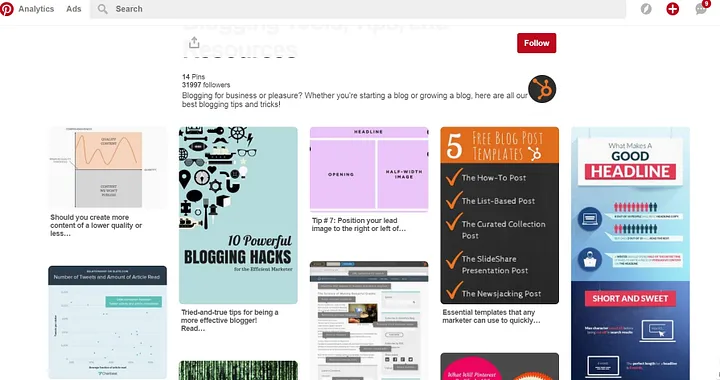
Here’s How to Actually Build Your Email List with Social Media
What “Social Media Gurus” Have Wrong
You’ll want to bookmark this post so you can take the time to implement all of the strategies 🙂
This is something I’ve been thinking about a lot lately.
I think a lot of business owners don’t know how to tell if the marketing activities they’re spending time on actually brings them a return on their time invested.
I think a lot of marketing agencies and social media “gurus” don’t even know how to tell!
The problem with social media marketing is too much time spent worrying about vanity metrics.
When I ask business owners about their social strategy, they’ll often tell me that they want to have so many Facebook fans or increase my Twitter followers.
But when I press them many can’t tell me why it’s important to their business to have more followers…
This drives me crazy!!

When you’re using social, yes being friendly, and warm, and posting frequently enough to register on the platform’s algorithm at all matter…
But doesn’t bringing dollars to your business matter more?
IS THAT NOT WHY YOU’RE ON THE PLATFORM IN THE FIRST PLACE??
I’m not a social media specialist. I’m a direct response copywriter, so I see the world quite differently from someone who lives in the world of social.
For many social media marketers their #1 priority is “engagement” and not results.
But don’t ask me, let them tell you themselves:

According to surveys done by TrustRadius, social media marketers value growing your followers and likes MORE than they value contributing to your website traffic, leads, or revenue…
So I wanted to give a different perspective on social media marketing because there is another way.
Look, we call things like followers and likes vanity metrics. Because you can make these numbers go up and up and up without seeing the effort put into it reflected in your bottom line.
Let me put it to you this way, do you care if 1,000,000 people retweet your Tweet if not a single one of those people resulted in a sale for you?
Probably not.
Unfortunately the way that the “social media gurus” instruct you to use social media often doesn’t lead to revenue results, because they don’t prioritize revenue results!
So instead, we’re going to flip this whole social media thing on its head and set some new goals.
Make this pledge with me:
NO LONGER will my social media efforts be for vanity, I will learn how to give value to my audience where success looks like new leads. — Tweet this
Here are our new goals for our social media activities:
- New customers
- New leads
- Website traffic
The case for engagement…
Engagement isn’t all bad.
The value in engagement is that it expands your reach on the platform, exposing you to new audience.
New audience are potential new leads, who are potential new customers.
I’m not trying to be down on social media marketers 🙂
All I’m saying is that I think we look at the purpose of engagement differently.
And to be honest, as told by the poll results above I just feel like for a lot of social media marketers the buck stops at engagement.
I disagree with that, and that’s the case I’m trying to make.
I see “engagement” metrics as a means to an end to:
- New customers
- New leads
- Website traffic
How would you use social media differently if getting New Customers was your #1 goal?
I’m sure you can already think of some changes you’d make!
Don’t just think of this as organic social, it’s your paid social too. For example, if you’re a brick and mortar business maybe instead of looking up hashtags related to your niche and “liking” those posts you would look up your GEOGRAPHIC AREA like your city and interact with posts regardless of whether or not they’re talking about your niche. (And that’s just the tip of the iceberg. Changing your goals will open your eyes to changing your strategies.)
In this guide we’re going to break down different email list building strategies for social media.
Why focus on building an email list instead of “engagement”?
Because unlike social media marketing, email subscribers are worth something either explicitly or implicitly.
What does that mean?
Let’s start with email subscribers are worth something explicitly.
If you have an email list of any substantial size, like 1,000 or even a few hundred, when you promote a call to action to them to buy a product, or to prospect them for a new service (for example by signing them up for a webinar), or you promote affiliate offers to them (even through affiliate programs like Amazon) then you can probably attribute some of your revenue to your email marketing.
Let’s say that in 1 year you made $24,000 that you can attribute to your email marketing.
That means that you offered your products or services to your email list, in an email, and some of those people who heard about your products from the email ultimately went forward and worked with you.
Or you write about the books that you’re reading and send that as an email to your list and you link out to the Amazon listing with an affiliate link and some people bought the books you recommend.
If you have 1,000 people on your email list, then each subscriber makes you $24 per year ($24000/1000 = $24).
Want to learn how to increase the profitability of your email list? Leave me a comment! It’s a little outside this article, but I could write another article about different strategies to monetize your list 🙂
So if you make $24 per year per subscriber, then you can spend well over $1–2 per lead and still be profitable.
You could also take this down to a monthly revenue per subscriber too! $24/12 (months) = $2.
Don’t freak out if your leads aren’t worth $2 per month! This number can range from a couple of cents per month to HUNDREDS of dollars per month depending on 1. How good you are at building relationships with your list and 2. How good you are a monetizing the list. If yours comes out to be only a few cents per month, that only means you have room to grow and improve your monetization of the list 🙂
Let’s say you spent about $300 on Facebook marketing this month, you can divide that by your cost per lead ($2) and give yourself a metric to check against how efficient your paid marketing spend is.
You’d want to have generated about 150 leads to come out at exactly breakeven for this month’s marketing spend.
What if you only got 50 leads for $300? Well, for 1 you might want to go back to the drawing board on your offer or your Facebook ad copy (or you could always try to make your email list more profitable) in future months but how long will it take you to recoup the cost of these leads?
$300/50 (leads) = $6 per lead, so it will take you about 3 months to make up for the cost of them being on your list. But that’s fine! Because if you’re making about $24 per subscriber, even though it will take you some time to make it up — you’ll still come out profitable on these leads 🙂
So now we know that email email subscribers have an explicit value, but what the heck does implicit value mean??
Don’t worry.
It sounds complicated, but it’s actually pretty simple 🙂
Imagine that you’re going to launch a new product, maybe an online course, and you’re going to do a webinar to promote that offer.
So you’re going to be doing a marketing campaign for webinar signups.
You could use Google AdWords to promote it, or paid marketing on Facebook and Twitter to get signups.
When you do it that way there’s a cost per action (CPA) involved with every new signup you get.
You could also send that offer to your email list.
The implicit value of email subscribers is what you would have had to pay to drive that traffic if you DIDN’T have an email list to do the heavy lifting. (In a way, that means that the more you grow your list the more it’s worth in implicit value — because instead of getting 50 signups with a small list you could fill up a whole webinar with 1–2,000 signups from a large list.)
So what does the implicit value of email subscribers look like?
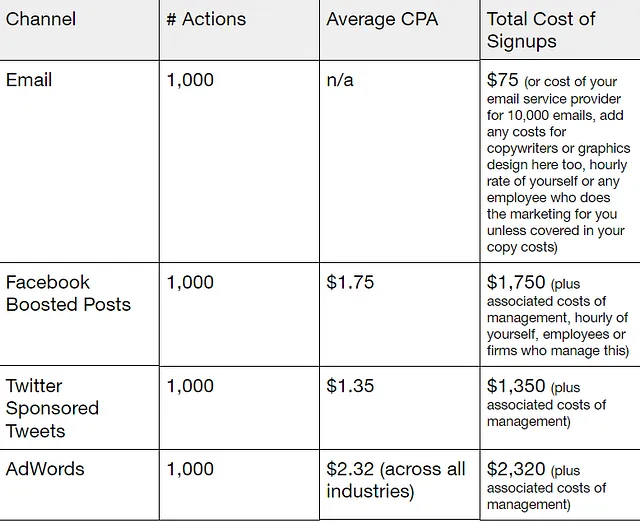
So if you’re able to fill the same marketing objectives from your email list instead of using paid placements the implicit value of your list is at least over $1,000 (aka What it’d cost to get those signups somewhere else).
Now that you understand why it’s better for your bottom line to focus on email subscribers rather than vanity metrics like Twitter followers, Facebook fans, or “engagement” let’s explore individual list building strategies for social media platforms.
We’ll cover some easy changes you can make to your Facebook, Twitter, Pinterest, and YouTube strategies plus I’ll share some other tools with you to make this process easier 🙂
But Before That… The Prep Work.
Look, like I said the impact that this makes on your business depends on how prepared you are.
Including how well you can form relationships with people on your list, and how well you can monetize your list.
The good news is that any email subscriber is at least worth more than 0 — and you can’t say the same about every Twitter follower or Facebook fan.
But if you don’t have a freebie offer that your audience actually wants, or you don’t have a very well developed sales funnel then you’re not going to see as good results as you could if you are more prepared!
So I wanted to share a few resources with you to guide you in more detail about how to set up these behind the scenes systems too.
First off, if you don’t know your audience well enough to immediately imagine right off the bat how you could help them then you’re going to want to take a look at this:
How to Ask Questions That Uncover Your Customer’s Needs
Customer Insights / 2025-01-22 / by Jamie THE MARKETING NERD
If you don’t already have a freebie to entice people to optin to your list, you can create your first here:
The Ultimate Guide to Growing Your List With Dope Lead Magnets
Business Strategies, Email Marketing / 2024-12-23 / by Jamie THE MARKETING NERD
If you don’t have a sales funnel set up AT ALL, these will get you started:
What You Absolutely Need to Know About Email Marketing
Business Strategies, Email Marketing / 2025-01-04 / by Jamie THE MARKETING NERD
How Can Welcome Emails Help You Win?
Business Strategies, Email Marketing / 2024-12-27 / by Jamie THE MARKETING NERD
How to Make a Sales Funnel for Any Industry
Customer Insights, Sales and Copywriting / 2024-10-03 / by Jamie THE MARKETING NERD
If you don’t email your list at all because you don’t know what to say, you’ll want to check this out:
What Should I Say in My Email Marketing?
Sales and Copywriting / 2024-12-12 / by Jamie THE MARKETING NERD
It’s important to email your list regularly, frequency of email (over once per week) is a top factor in the most profitable lists.
You’ll find that extremely profitable lists have:
- Frequent list contact (more than once per week)
- A deep sales funnel (with low and high end offers)
- Affiliate offers (from other figures your audience trusts, for example Amy Porterfield promoting Marie Forleo’s B-School)
- Continuity elements (things that happen outside of the list like podcasts, blogs, membership sites, courses, mentoring programs, other recurring services)
Once you have at least one (but maybe several!) content optins, a landing page, a sales funnel, and an idea on how you’ll create an engaged list — then you’re in great shape to profit from list building!
Helpful Tools for Social Media Marketing
Before we get into the tactics for individual platforms, I wanted to share some tools with you. These tools are the nuts and bolts that will glue your social media list building strategy together.
Making landing pages
You can always check out subscription services like Leadpages or Clickfunnels to do your landing pages.
But I always like to tell people about my favorite way to make landing pages: Thrive Architect.
The reason why I like it so much better is that instead of a monthly subscription fee, this is a one time purchase of $67.
You get a plugin that you install on your WordPress site, and then you get the same kind of drag and drop interface that those other services have without the added cost.
Track results
This tool is a URL shortener called Pretty Links.
You know Bit.ly or Goo.gl? Well now you can create short links, or links that “forward” to another one from your own domain — right from the WordPress Dashboard.
Just like Google Analytics you’ll get some charts and information about when people clicked your link or where they came from. Except now you’ll be building your own brand recognition instead of someone else’s.
This is especially helpful for if you have an affiliate link, a quote request form that’s actually a Google Doc, or if you use something like Leadpages or SamCart where your funnels have an external URL.
Getting email subscribers
It’s important to have a way to maintain a relationship with your website visitors.
I have 2 tools to share with you for this purpose:
The first Thrive Leads.
Like the earlier landing page tool I mentioned, this email optin form creator integrates with most email marketing softwares and there’s a simple drag and drop interface to create new email subscription forms.
This is used by the pros like (John Lee Dumas), and again it’s just a simple $67 fee for 1 license.
I’m a fan of Thrive Leads over other options like SumoMe because of the fact that it’s so powerful — but it’s a one time fee and not a monthly subscription.
For entrepreneurs on a budget, Icegram is a great free alternative to check out.
It’s quite customizable and you can make a few different styles of forms.
Get more social shares
I’m a fan of Social Warfare as a social share plugin because it has a lot of features.
When you embed email optin forms at the bottom of your blog posts with some of the earlier tools, then it’s beneficial for you to get more social shares.
You’re now ready to convert those shares into more website traffic and collect the information of warm leads.
I’m a fan of using embeddable email optin forms at the bottom of your blog posts instead of popups, because then you’re collecting warm leads who have consumed your entire piece of content.
All 6-Figure Internet Marketers Do This…
Here’s a sneaky trick that most professional online marketers, from solo-ishpreneurs like Pat Flynn to established companies like ConvertKit, use:
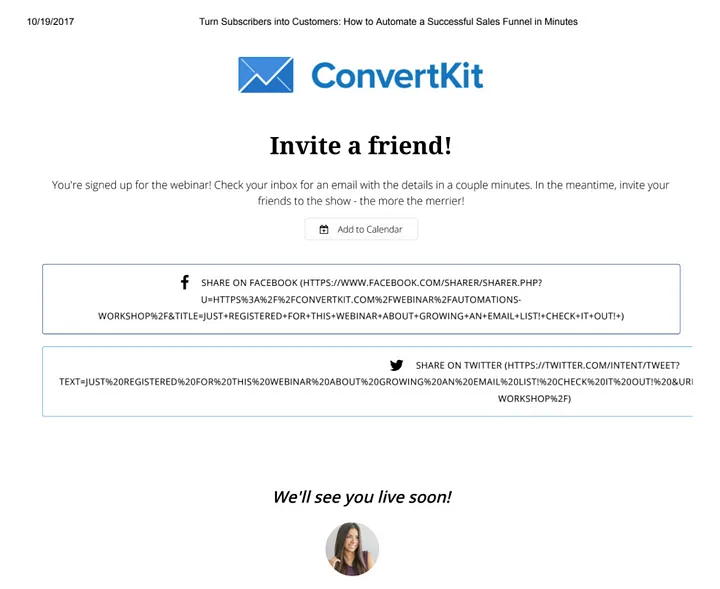
When you have a freebie optin the viewer usually gets redirected to a Thank You page.
On that Thank You page often times there’s a call to action to share what you just learned with your friends on social media.
How do they make hyperlinks that you click on and it makes you share a message to whatever social media profile?
You can use the website Share Link Generator to do just that.
With this website it’s as simple as pasting the URL you want to send people to and the message you want them to share into the proper box for whatever social media network you’d like to offer.
There are many other websites that do this, but what I like about Share Link Generator is that there’s a variety of social media platforms in this one site.
Now that I’ve shared some tools, lets move onto specific tactics for different social media platforms…
After you’ve set up your landing page with your content optin, you’ve got to promote it.
One underused place to promote your offer is in your Facebook cover photo.
It’s often overlooked by so many people, but you can get pretty creative with drawing attention to a web address in your cover photo by having graphics with button-like images designed.
Here are 2 examples on how you could incorporate a call to action for your optin in your Facebook cover photo:
Amy Porterfield
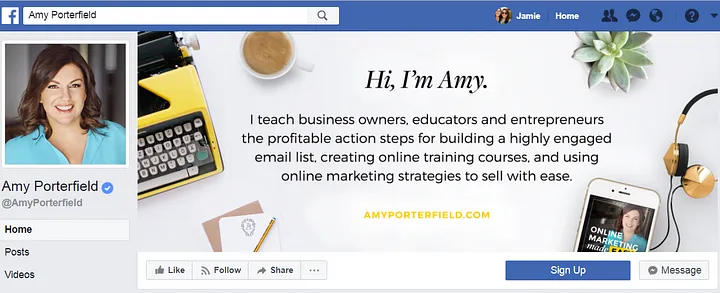
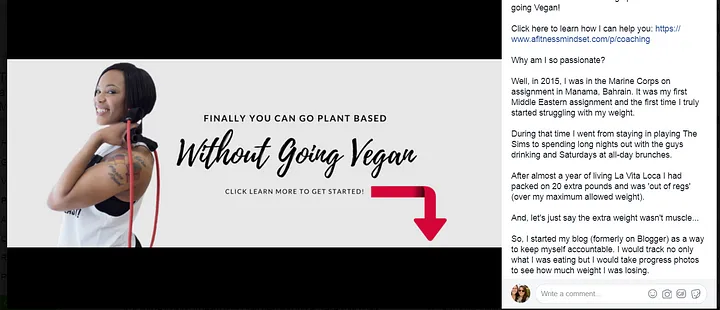
The Art of the Contest
You may have seen a “Facebook giveaway” before, but if you haven’t I wanted to share this as a great strategy for growing your audience — but specifically for getting people’s email addresses.
I’m going to share 2 tools with you, and whichever tool you decide to use they both have the option of requiring an email address for entry.
The first Facebook/social media contest tool I wanted to share with you is Gleam.io.
What I like about Gleam.io is that you can set up your contest for free, start collecting entries, and then pay after the fact for some of the more advanced features (that’s what I did when I was on a budget).
The second contest tool I wanted to share with you is what the pros use:
Contest Domination is a little pricier than Gleam.io, but there are a lot of advanced features.
If you think that you’re going to use contests as a main lead generation mechanic for your business (which would be a great idea for all local businesses, because you can use giving away your products as an excuse to generate publicity and get people into your store to collect the prizes with monthly or quarterly contests) you should probably go with this one.
It integrates with a bunch of tools, including some webinar tools and there are a bunch more campaign management options which are useful if you’re managing several contests.
Another simple win first, something that a lot of people don’t think about with Twitter is that URL’s in the bio are also clickable. (Unlike platforms like Instagram where only the bio link clicks out and other URLs are text.)
So I would highlight your optin offer in your Twitter URL, and then use the bio text to add your homepage at the end of your bio message.
For those of us who want to get fancier, here’s a great hack for your pinned Tweet:
What are Twitter cards?
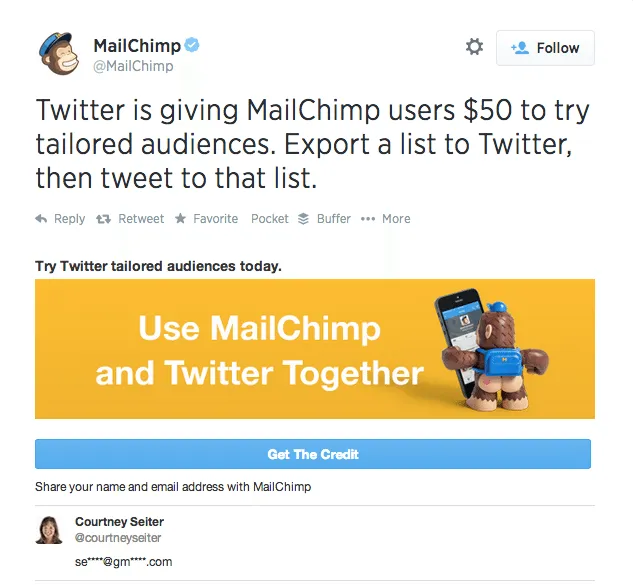
Twitter cards look like large, featured Tweets.
One style of card you can create is a lead generation card. This is much like the Lead Generation Facebook ad form we talked about last week, where you can offer Twitter followers an offer and if they’re interested the lead generation form is already prefilled with the email address they use Twitter with.
Then you can pin this Tweet to the top of your profile and CONSTANTLY be collecting leads as people view your profile:
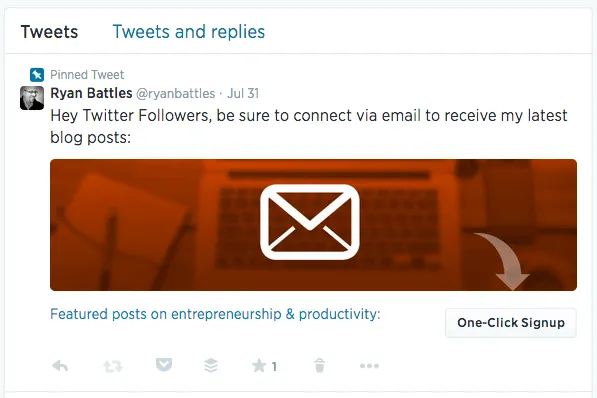
Here are more detailed directions on how to set up a lead generation Twitter card on your on profile:

Larger images like 1200 X 675 work really well for Twitter cards because they’ll downscale nicely on cell phones but also look great for desktop users. The display size of Twitter card images is 600 x 335.
I just wanted to talk about Pinterest because I think a lot of us ignore it as a traffic source.
You might think of Pinterest as the home of pumpkin spice lattes and galaxy nail tutorials, but Pinterest is actually the 2nd largest referrer of traffic besides Facebook.
The simplest thing that all of us could do is to Pin each and every one of our blog posts to Pinterest with a cool graphic (long images work really well, even vertical printer paper dimensions) and a longggggg benefit oriented description (long descriptions overindex on Pinterest).
Hubspot is a great source of inspiration for this:
You could also periodically share images and descriptions of your optin landing pages.
You can share the same link while mixing up the image and description on Pinterest to reach new audiences.
Again, on all of these sites think about changing your profile URL to your landing page’s URL (direct to your freebie optin squeeze page) instead of using your homepage. (Unless you’ve conversion optimized your homepage.)
For those of us who forget to do this, CoSchedule is a great tool.
YouTube
When you’re creating YouTube content you’ll want to be sure that you’re taking every opportunity to give your call to actions.
First priority: Are you adding a call to action in the first line of your description text?
Remember that, again, links in the YouTube description are hotlinks and do click out.
So try to make sure that a relevant call to action with a link to your squeeze page is above the fold (visible without clicking “see more).
Second priority: Enforcing your calls to action with on screen calls to action and clickable links.
Did you know you can add pictures on your video IN YouTube?
Using a picture editor like Canva or Photoshop you can make a .PNG graphic (so it has a transparent background) that has a headline and a link to your squeeze page.
You can display this call to action underneath your face (think of the names under anchors on the news) during the content of your video to get viewers to become leads.
Try the dimensions 800 x 100 to start, but you might have to play around with it depending on how you’ve framed your shots.
You’ll also want to create End Screens that deliver a call to actoin like sharing the URL of a relevant content optin squeeze page where you can click out to URLs:
Thanks for reading! Did this guide help you? Please spread the word by hitting the 👏 button and share on Facebook, or Twitter if you find the article valuable 🙂
If there’s anything I hope you take from this article it’s to think differently about why you do social media marketing.
I’m not saying that you should be spammy and ignore what your audience finds interesting.
I’m just saying you should keep your eye on the ball when social media marketing.
Do you REALLY need to be active on 142 social networks when you could survey your audience and just narrow down only which platforms they use?
Would you rather have a “following” of 645,032 bot followers on [whatever platform], or a following of 630 who evangelists who do tell their friends about you, and do buy your products?
Instead of setting goals like get more engagement for our social media content I just want you to see that the best measure of true engagement is actually leads and dollars.
Social media is great for:
- Getting new customers
- Getting new leads
- Getting website traffic
Not just engagement 😉

